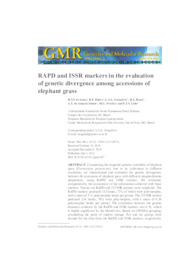RAPD and ISSR markers in the evaluation of genetic divergence among accessions of elephant grass.
RAPD and ISSR markers in the evaluation of genetic divergence among accessions of elephant grass.
Author(s): LIMA, R. S. N. de; DAHER, R. F.; GONÇALVES, L. S. A.; ROSSI, D. A.; AMARAL JÚNIOR, A. T. do; PEREIRA, M. G.; LEDO, F. J. da S.
Summary: Considering the expected genetic variability of elephant grass (Pennisetum purpureum), due to its cultivation in different continents, we characterized and estimated the genetic divergences between 46 accessions of elephant grass with different edaphoclimatic adaptations, using RAPD and ISSR markers. We evaluated, comparatively, the consistency of the information achieved with these markers. Twenty-six RAPD and 25 ISSR primers were employed. The RAPD markers produced 185 bands, 72% of which were polymorphic, with a mean of 5.11 polymorphic bands per primer. The 25 ISSR starters produced 216 bands; 76% were polymorphic, with a mean of 6.56 polymorphic bands per primer. The correlation between the genetic distances achieved by the RAPD and ISSR markers was 0.76, which is highly significant by the Mantel test. Based on UPGMA grouping, considering the point of sudden change, five and six groups were formed for the data from the RAPD and ISSR markers, respectively. These markers provided partially concordant groups, indicating that these techniques can provide consistent information and consequently could be used in studies of genetic diversity among accessions.
Publication year: 2011
Types of publication: Journal article
Unit: Embrapa Dairy Cattle
Observation
Some of Embrapa's publications are published as ePub files. To read them, use or download one of the following free software options to your computer or mobile device. Android: Google Play Books; IOS: iBooks; Windows and Linux: Calibre.
Access other publications
Access the Agricultural Research Database (BDPA) to consult Embrapa's full library collection and records.
Visit Embrapa Bookstore to purchase books and other publications sold by Embrapa.

